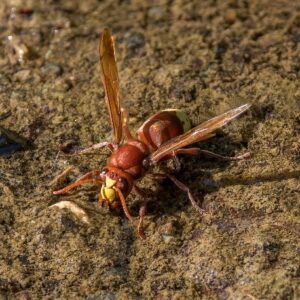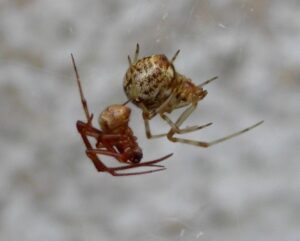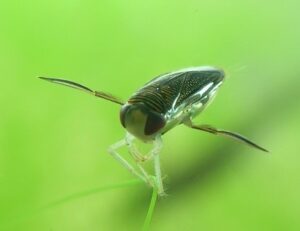Oriental Wasp – Vespa orientalis Linnaeus
General Description
| · The adult insect is about 2.5-3 cm long.
· The general color of the body is reddish-brown, and the wings are yellowish-brown. The faces are yellow, as are the posterior margins of the second, fourth, and fifth ventral segments. · The male’s abdomen consists of seven segments, while the female’s abdomen consists of only six. · The antennae consist of 13 segments in the male and 12 segments in the female. |

Credit: Charles J. Sharp |
- The male is smaller than the queen but equal to the worker in size.
- The wasp nest consists of a queen, who is the only fertile female who lays eggs, some males who mate with the queens and fertilize them, and the workers, who are females and are usually sterile, and the workers may sometimes lay unfertilized eggs when the queen dies before the end of the season. There may be several queens in one nest.
Life Cycle and Common Characteristics
- The fertilized queens appear in early March, and their number increases in April. These queens build their nests and take the walls of abandoned houses or the ground as places for them.
- The eggs are laid in cells of mud, and when the larvae are fully grown, they turn into a virgin. At the end of the virgin phase, which takes 12 days, the full insect emerges.
- The number of worker bees increases from August to November (and reaches its maximum number in October and then decreases).
- At the end of summer, queens and males appear, and males arise from unfertilized eggs, then fertilization of these virgin queens occurs in late autumn (October and November). Colony, where all males, workers, and the queen’s mother died. The fertilized queens emerge from their nests in the early spring of the following year to repeat the life cycle.
- Oriental wasps are restricted to areas with underground cavities which can be exploited as nesting sites. In urban areas, nests are found in cavity walls, subfloor crawl spaces, roof spaces, and in outdoor stockpiles of goods such as building materials.
- The peak size of the colony is a few thousand individuals and a colony typically contains three to six combs, each containing 600-900 individual cells.
- Wasps that attack honey bee colonies live socially in the form of colonies inside nests containing hexagonal sells, where they build their nests from leaves or mud under or above the surface of the earth or in cracks in buildings or canal bridges.
- They are stinging insects, and under normal conditions, they feed on the nectar of flowers and collect other insects that they capture in order to feed their young.
- Oriental hornets communicate through sound vibrations.
Damages and Economic & Medical Implications
- Oriental wasps are among the pests that exist in apiaries in many countries.
- The adult attacks bee hives and causes the death of a large number of their workers.
- Venom is regarded as a potential therapeutic agent.
- o deaths are attributed to yellowjackets.




